Lessico
Sorbo
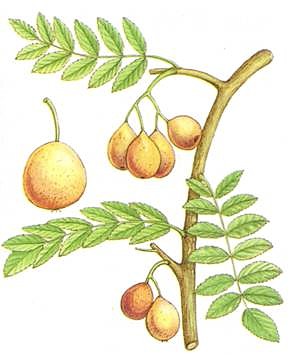
Sorbus domestica
L'etimologia
del latino sorbus è incerta, ma secondo alcuni deriverebbe dal verbo sorbeo
= bere, assorbire, in quanto i frutti del sorbo arresterebbero i flussi
dell'intestino Di questo avviso terapeutico erano Dioscoride![]() (il
frutto lo chiamava οὖα
(il
frutto lo chiamava οὖα![]() ), Galeno
), Galeno![]() nonché Mattioli
nonché Mattioli![]() . Tuttavia pare assai più verosimile un'etimologia
indoeuropea, da *sor-bho = rosso, il colore dei frutti. Il sostantivo plurale
bolognese sorbole esprime meraviglia, stupore e simili (sorbole! quante arie
ti dai!) equivale a sorbe, plurale di sorba, il frutto del sorbo.
. Tuttavia pare assai più verosimile un'etimologia
indoeuropea, da *sor-bho = rosso, il colore dei frutti. Il sostantivo plurale
bolognese sorbole esprime meraviglia, stupore e simili (sorbole! quante arie
ti dai!) equivale a sorbe, plurale di sorba, il frutto del sorbo.
Sorbus: genere di alberi o alberelli della
famiglia Rosacee originari dell'Asia e spontanei nei boschi o coltivati per
ornamento o per i frutti eduli. Il sorbo domestico (Sorbus domestica = Pyrus
domestica![]() ) è molto simile al pero, con foglie composte
imparipennate, fiori riuniti in corimbi rosati e frutti (sorbe) ovali,
rossastri, che, staccati dalla pianta e fatti leggermente fermentare, assumono
colore rugginoso e sapore gradevole. Il sorbo montano (Sorbus aria
) è molto simile al pero, con foglie composte
imparipennate, fiori riuniti in corimbi rosati e frutti (sorbe) ovali,
rossastri, che, staccati dalla pianta e fatti leggermente fermentare, assumono
colore rugginoso e sapore gradevole. Il sorbo montano (Sorbus aria![]() ), detto anche farinaccio, ha foglie ovali, dentate,
con spruzzature biancastre sulla pagina inferiore, fiori bianchi e frutti
rossi, commestibili. Il sorbo degli uccellatori (Sorbus aucuparia
), detto anche farinaccio, ha foglie ovali, dentate,
con spruzzature biancastre sulla pagina inferiore, fiori bianchi e frutti
rossi, commestibili. Il sorbo degli uccellatori (Sorbus aucuparia![]() ), con foglie composte da 5-13 foglioline e fiori
bianchi raccolti in corimbi, è coltivato come albero ornamentale per i frutti
di color rosso non eduli e di lunga durata. Il Sorbus torminalis
), con foglie composte da 5-13 foglioline e fiori
bianchi raccolti in corimbi, è coltivato come albero ornamentale per i frutti
di color rosso non eduli e di lunga durata. Il Sorbus torminalis![]() è noto come baccarello.
è noto come baccarello.
In contrasto con la decantata azione astringente della sorba - grazie al verbo sorbeo - è quella esplicata dal sorbitolo, composto chimico di formula bruta C6H14O6, alcol esavalente, uno degli isomeri dell'esite. Il sorbitolo, che deve il suo nome al fatto di essere stato isolato dai frutti del sorbo, si presenta come un solido cristallino incolore, solubilissimo in acqua e dal sapore appena debolmente dolce. Presente nella frutta (mele, pere, ciliegie), nelle barbabietole e in diverse specie di alghe, si ottiene industrialmente per riduzione del D-glucosio in presenza di catalizzatori metallici. Prodotto di partenza nella preparazione del sorbosio, dell'acido ascorbico, del glicole propilenico, viene inoltre adoperato nell'industria delle vernici e delle materie plastiche, nella produzione di inchiostri da stampa e delle miscele anticongelanti. In medicina è usato come purgante e diuretico, oltre che come dolcificante alimentare per i diabetici.
Sorbo
Il genere Sorbus (genericamente Sorbo) comprende alberi e arbusti della famiglia delle Rosacee. Le specie appartenenti al genere Sorbus sono molto numerose e producono tutte frutti simili, ma molto diversi per grandezza e anche per colore. Dante Alighieri lo cita come frutto aspro, in contrapposizione al fico, che ha frutti dolci.
«
ed è ragion, ché tra li lazzi sorbi
si disconvien fruttare al dolce fico. »
(Dante, Inferno, XV, 65-65)
È ampiamente diffuso nei boschi e nei luoghi rocciosi. Nella regione mediterranea è diffuso anche sui monti. A seconda della specie può essere un arbusto o alberello o anche un albero alto fino a 12 m, ha la corteccia grigia con chiazze bianche; rami giovani pubescenti, poi glabri, bruno-rossicci. Le foglie sono alterne, picciolate, semplici, spesso coriacee di forma da ellittica a ovata con apice acuto e margini irregolarmente seghettati. Hanno la pagina superiore color verde-scuro, quella inferiore color argenteo. Ha infiorescenze a corimbi eretti di 5-8 cm con fiori bianchi. Fiorisce a maggio-giugno
I frutti sono pomi ovoidali o rotondi, di dimensioni variabili da 1 a 3 cm a seconda della specie, rosso aranciati quando maturi. I frutti del sorbo domestico sono entrati in passato a far parte dell'alimentazione umana, ma oggi non vengono più consumati comunemente. I frutti di alcune specie sono stati usati in erboristeria sin dall'antichità, soprattutto per il loro alto contenuto di vitamina C. Il legno di alcune specie trova vari utilizzi. A scopo forestale, le specie usate sono il sorbo degli uccellatori, il sorbo ciavardello e il sorbo montano.
Sorbus is a genus of about 100–200 species of trees and shrubs in the subfamily Maloideae of the Rose family Rosaceae. Species of Sorbus (s.l.) are commonly known as whitebeam, rowan, service tree, and mountain ash. The exact number of species is disputed depending on the circumscription of the genus, and also due to the number of apomictic microspecies, which some treat as distinct species but others group in a smaller number of variable species. Recent treatments treat Sorbus in a narrower sense to include only the pinnate-leaved species of subgenus Sorbus, raising several of the other subgenera to generic rank. As treated in its broad sense, the genus is divided into two main and three or four small subgenera (with more recent generic assignments in parentheses):
Sorbus subgenus Sorbus (genus Sorbus s.s.), commonly known as the rowan (primarily in the UK) or mountain ash (in both North America and the UK), with compound leaves usually hairless or thinly hairy below; fruit carpels not fused; type species Sorbus aucuparia (European rowan). Distribution: cool-temperate Northern Hemisphere. (Genus Sorbus s.s.)
Sorbus subgenus Aria (genus Aria), the whitebeam, with simple leaves usually strongly white-hairy below (hence the name, from German Weissbaum, 'white tree'); fruit carpels not fused; type species Sorbus aria (common whitebeam). Distribution: temperate Europe & Asia.
Sorbus subgenus Micromeles (genus Aria), an indistinct group of a few east Asian species (e.g. Sorbus alnifolia, Korean whitebeam) with narrow leaves; doubtfully distinct from and often included in subgenus Aria. Distribution: temperate northeast Asia.
Sorbus subgenus Cormus (genus Cormus), with compound leaves similar to subgenus Sorbus, but with distinct fused carpels in the fruit; just one species, Sorbus domestica (True Service Tree). Distribution: North Africa, warm-temperate Europe, West Asia.
Sorbus subgenus Torminaria (genus Torminalis), with rather maple-like lobed leaves with pointed lobes; fruit carpels not fused; just one species, Sorbus torminalis (Wild Service Tree). Distribution: temperate Europe, south to the mountains of North Africa and east to the Caucasus ranges.
Sorbus subgenus Chamaemespilus (genus Chamaemespilus), a single shrubby species Sorbus chamaemespilus (false medlar) with simple, glabrous leaves and pink flowers with erect sepals and petals. Distribution: mountains of southern Europe.
Hybrids are common in the genus, including many between the subgenera; very often these hybrids are apomictic (self-fertile without pollination), so able to reproduce clonally from seed without any variation. This has led to a very large number of microspecies, particularly in western Europe (including Britain) and parts of China. Sorbus species are used as food plants by the larvae of some moth species. Sorbus is also a fortified Finnish fruit wine flavoured with rowan berries. Sorbus domestica is used to flavour some apple wines.
Sorbus
domestica
Sorbo domestico

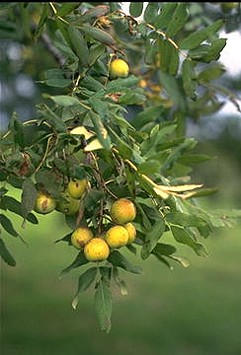
Il Sorbo domestico (Sorbus domestica L.) appartiene alla Famiglia delle Rosaceae. È una specie originaria dell'Europa Meridionale, dalla Spagna alla Crimea e all'Asia Minore, spesso coltivata per i frutti anche fuori dal proprio areale. In Italia si trova sporadico in tutta la penisola e nelle isole, nei boschi montani di latifoglie preferenzialmente su substrato calcareo. Albero alto fino a 13 metri, molto longevo; i rami sono grigio tomentosi poi glabri, con gemma quasi glabra e vischiosa. Foglie alterne imparipennate, composte, lunghe fino a 20 cm, con 6-10 paia di foglioline ovali o lanceolate sessili, dentate ai margini, acute all'apice, sopra glauche e tomentose sotto.
Fiori ermafroditi numerosi, in corimbi ramosi e tomentosi; calice a cinque lacinie triangolari acute; corolle a cinque petali (5-7 mm) bianchi rotondeggianti; stami 20; stili 5 comiati alla base. Il frutto è un pomo subgloboso o piriforme lungo da 2 a 4 centimetri, di colore giallo-rossastro e punteggiato, quindi bruno a maturità; la polpa è verdognola dolce, con endocarpo membranaceo e semi angolosi bruni. I frutti maturano in autunno e sono molto ricercati dalla fauna selvatica. I frutti sono commestibili, di sapore acidulo, ricchi di acido malico e vitamina C, se ammezziti diventano dolci, con polpa farinosa molle. Esistono varietà che differiscono per forma e pezzatura del frutto.
Non edule al momento della raccolta. Commestibile solo dopo ammezzimento. Si utilizzano per fare sidro, confetture, liquori e salse. In fitoterapia i frutti hanno proprietà astringenti, diuretiche, detergenti, rinfrescanti e tonificanti. Dal legno giovane si estrae un liquido scuro per tingere tessuti. Il tannino estratto dalle foglie un tempo serviva per la concia delle pelli. Il legno, colorato in rosso bruno, ad alburno più chiaro, è duro ed elastico e trova impiego nella costruzione di pezzi sottoposti a forte attrito, oltre che in falegnameria per attrezzi rurali e casalinghi, lavori da tornio e intaglio. Il Sorbo, è indicato per la coltivazione biologica e per la valorizzazione di zone marginali. Impiegato a scopo ornamentale.
www.agraria.org
Service
Tree
Sorbus domestica
Sorbus domestica (Service Tree, or sometimes True Service Tree to distinguish it from the Wild Service Tree; syn. Cormus domestica (L.) Spach) is a species of Sorbus native to western, central and southern Europe, northwest Africa (Atlas Mountains), and southwest Asia (east to the Caucasus). It is a deciduous tree growing to 15–20 m (rarely to 30 m) tall with a trunk up to 1 m diameter, though can also be a shrub 2–3 m tall on exposed sites. The bark is brown, smooth on young trees, becoming fissured and flaky on old trees. The winter buds are green, with a sticky resinous coating. The leaves are 15–25 cm long, pinnate with 13-21 leaflets 3–6 cm long and 1 cm broad, with a bluntly acute apex, and a serrated margin on the outer half or two thirds of the leaflet. The flowers are 13–18 mm diameter, with five white petals and 20 creamy-white stamens; they are produced in corymbs 10–14 cm diameter in late spring, and are hermaphrodite and insect pollinated. The fruit is a pome 2–3 cm long, greenish-brown, often tinged red on the side exposed to sunlight; it can be either apple-shaped (f. pomifera (Hayne) Rehder) or pear-shaped (f. pyrifera (Hayne) Rehder).
It is generally rare, being listed as an endangered species in Switzerland and Austria, and uncommon in Spain. In the UK, one very old tree that existed in the Wyre Forest before being destroyed in 1862 used to be considered native, but it is now generally considered to be more likely of cultivated origin, probably from a mediaeval monastery orchard planting. More recently, a small population of genuinely wild specimens was found growing as stunted shrubs on cliffs in south Wales (Glamorgan) and nearby southwest England (Gloucestershire). It is a very rare species in Britain, occurring at only a handful of sites. Its largest English population is within the Horseshoe Bend Site of Special Scientific Interest at Shirehampton, near Bristol. It is not otherwise widely cultivated in the UK.
It is a long-lived tree, with ages of 300–400 years estimated for some in Britain. The largest and perhaps oldest known specimen in Europe is near the town of Strážnice in the province of Moravia, Czech Republic. Its trunk measures 458 cm in circumference, with a crown 11 m high and 18 m across. It is estimated to be around 400 years old.
The fruit is a component of a cider-like drink which is still made in parts of Europe. Picked straight off the tree, it is highly astringent and gritty; however, when left to blet (over-ripen) it sweetens and becomes pleasant to eat.
The English name is derived from its Latin name sorbus by way of Old English syrfe; it is unrelated to the English verb "to serve". Other English names include Sorb or Sorb Tree; and Whitty Pear —"whitty" because the leaves are similar to Rowan (i.e. pinnate), and "pear" due to the nature of the fruit.
Sorbus
aucuparia
Sorbo degli uccellatori
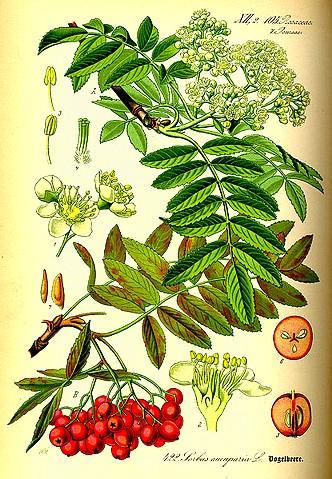
Il Sorbo degli uccellatori (Sorbus aucuparia L.) è un albero della famiglia delle Rosacee. Il nome deriva dal fatto che, essendo le sue bacche appetite dalla piccola avifauna migratoria, viene tradizionalmente utilizzato negli appostamenti fissi per la caccia a tali prede. Veniva anche piantato attorno agli impianti per la cattura di tale fauna mediante reti. È diffuso nelle zone temperate dell'Europa dall'Islanda alla Russia. Sono state descritte le seguenti sottospecie:
Sorbus
aucuparia subsp. aucuparia
Sorbus aucuparia subsp. fenenkiana
T.Georgiev & Stoj. - endemismo bulgaro
Sorbus aucuparia subsp. glabrata
(Wimm. & Grab.) Cajander
Sorbus aucuparia subsp. praemorsa
(Guss.) Nyman - endemismo siculo-corso
Sorbus aucuparia subsp. sibirica
(Hedl.) Krylov
Rowan
or European Rowan
Sorbus aucuparia
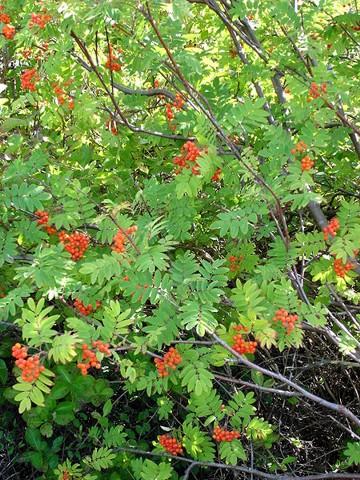
Sorbus aucuparia (Rowan or European Rowan), is a species of the genus Sorbus (subgenus Sorbus), native to most of Europe except for the far south, and northern Asia. In the south of its range in the Mediterranean region it is confined to high altitudes in mountains. It has received many alternative names, the most frequently seen being "Mountain Ash"
It is a small to medium-sized deciduous tree typically growing to 8–10 m tall, more rarely 20 m, and exceptionally to 28 m. The bark is smooth, silvery grey of young trees, becoming scaly pale grey-brown and occasionally fissured on old trees. The shoots are green and variably hairy at first, becoming grey-brown and hairless; the buds are conspicuous, purple-brown, and often densely hairy. The leaves are pinnate, 10–22 cm long and 6-12 cm broad, with 9–19 (most often 13–15) leaflets; each leaflet is 3–7 cm long and 15–23 mm broad, with a coarsely serrated margin; they are variably hairy, particularly the petiole and leaf veins on the underside. The hermaphrodite flowers are produced in large terminal corymbs 8–15 cm diameter with up to 250 flowers, the individual flowers 1 cm diameter, with five creamy-white petals, and are insect pollinated. The fruit is a small pome 6–9 mm (rarely up to 14 mm) diameter, green at first, ripening bright red in late summer, and containing up to eight (most commonly two) small seeds. It is diploid, with a chromosome count of 2n=34. Five subspecies are recognised:
Sorbus aucuparia subsp. aucuparia. Temperate Europe and northwest Asia, south to central Spain, central Italy, and northernmost Greece, and east to the Ob and Irtysh rivers. Tree form; leaves and shoots hairy.
Sorbus aucuparia subsp. fenenkiana T.Georgiev & Stoj. Bulgaria (endemic).
Sorbus aucuparia subsp. glabrata (Wimm. & Grab.) Cajander. (syn. S. glabrata (Wimm. & Grab.) Hedl.). Subarctic regions, from Iceland, northernmost Scotland (Orkney, Shetland), northern Scandinavia, northwest Russia, and also locally at tree line in central Europe in the Alps and Carpathians. Shrubby; leaves and shoots less hairy.
Sorbus aucuparia subsp. praemorsa (Guss.) Nyman. High altitudes in the Mediterranean region in France (Corsica) and Italy (Sicily and Calabria).
Sorbus aucuparia subsp. sibirica (Hedl.) Krylov (syn. S. sibirica Hedl.). Temperate northern Asia, east of the Ob and Irtysh rivers. Tree form; leaves and shoots hairless.
Rowan is very tolerant of cold and is often found at high altitude on mountains; in the UK it occurs at up to 1 000 m altitude, higher than any other tree, and in France up to 2 000 m. It is very tolerant of a wide range of soil conditions, including thin acid soils and cracks in cliffs. It also fairly frequently grows as an epiphyte in clefts or cavities of larger trees such as Scots Pines, though epiphytic specimens rarely have growing conditions adequate for them to reach maturity. The fruit is an important food resource for many birds, notably Redwings, Fieldfares, Blackbirds, Mistle Thrushes and Waxwings, which in turn disperse the seeds in their droppings. The seeds are eaten by Pine Grosbeaks and other large finches. The foliage and bark is eaten by Red Deer, Roe Deer, and Mountain Hares, and a small number of insect larvae, including leaf-miners in the genus Stigmella, and the moth Venusia cambrica. The snail Helix aspersa also feeds on the leaves.
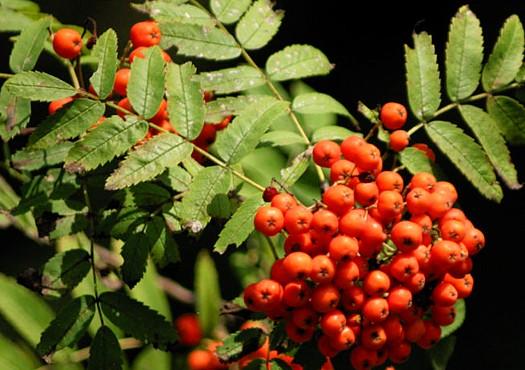
Like other rowans, it is widely grown as an ornamental tree. Several cultivars have been selected, including 'Asplenifolia' with very deeply serrated leaves, 'Beissneri' with coppery-orange bark and erect branching, and 'Fructu Luteo' with yellow fruit. The fruit, called rowan berries in culinary usage, are usually very bitter and inedible fresh, but are used to make jam or jelly, with a distinctive bitter flavour. Rowan jelly is a traditional accompaniment to game and venison. The cultivar 'Edulis' has been selected for its less bitter fruit. In the United Kingdom, where it is often known as the wiggen tree, the Mountain Ash has traditionally been used as an anti-witching device.
Sorbus
aria
Sorbo montano
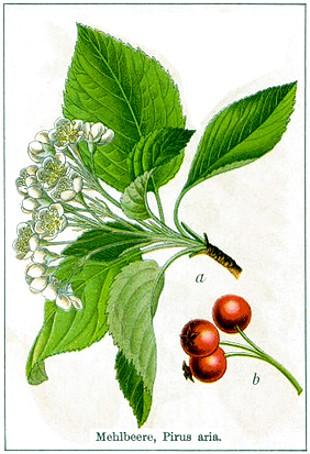
L'aggettivo aria pare sia dovuto agli Ariani o Arii, popoli appartenenti al ceppo linguistico indoeuropeo che nel XIV secolo aC migrarono verso est, si spinsero nell'India nordoccidentale abbandonando i territori afghani e iraniani; conquistarono prima il Punjab, poi altre zone dell'India. Gli ariani consideravano il colore chiaro della loro pelle un privilegio e cercarono di evitare la contaminazione con i popoli autoctoni di pelle scura.
Il sorbo montano, o farinaccio, è distribuito in tutta l’Europa, eccetto le regioni scandinave. Vive nei boschi collinari o montani fino a 1600 m di altitudine. Ama i terreni calcarei, ma si adatta anche ad altri; ama il sole e tollera bene aridità e basse temperature. Ha crescita lenta ed è molto longevo. Il legno è duro e forte, ma ha impieghi limitati anche per le modeste dimensioni del fusto. I frutti sono commestibili ed erano utilizzati per fare una salsa per la cacciagione; in tempi di carestia la loro polpa farinosa era mescolata nel pane. Oggi è utilizzato per alberature anche perché, per gran parte dell’anno, è molto attraente grazie al colore primaverile e autunnale delle foglie e a quello dei frutti.
Habitat - Ampiamente diffuso nei boschi e nei luoghi rocciosi. Nella regione mediterranea diffuso anche sui monti.
Fusto - Albero alto fino a 12 m o alberello. Corteccia grigia con chiazze bianche; rami giovani pubescenti, poi glabri, bruno-rossicci.
Foglie - Alterne, picciolate, semplici, spesso coriacee di forma da ellittica a ovata con apice acuto e margini irregolarmente seghettati. Pagina superiore color verde-scuro. inferiore color argenteo.
Fiori - Infiorescenze a corimbi eretti di 5-8 cm con fiori bianchi; fioritura a maggio-giugno
Frutti - Pomi ovoidali di 1,5 cm, rosso aranciati quando maturi e commestibili.
www.altavaltrebbia.net
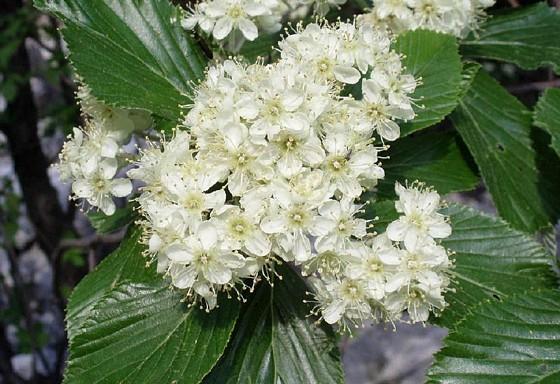
Curiosità su Sorbus aria
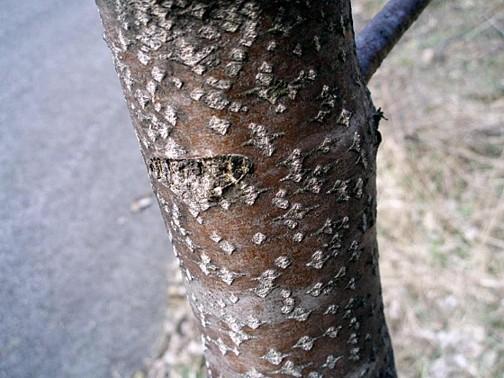
Chi attraversa i querceti termofili su suolo calcareo durante i mesi autunnali, non può far a meno di notare la sparsa presenza del sorbo montano, dai cui rami pendono in modo appariscente i suoi frutti rossi, tondeggianti, tomentosi, picchiettati di numerose lenticelle nerastre e riuniti in corimbi di 10-40 esemplari; anche in primavera l’albero si riconosce facilmente sia per la bianca e decorativa fioritura, sia perché le sue foglie ovali od obovate, intere e a margine irregolarmente dentato, mosse dal vento, scintillano, mostrando la loro pagina inferiore interamente bianco-candida rispetto alla pagina superiore completamente verde (per cui si distinguono da quelle di Viburnum lantana L., che hanno la lamina verde in entrambe le facce).
La spiegazione del binomio scientifico non è così semplice come sembra; infatti il nome del genere, pur restando sempre nell’ambito della famiglia delle Rosacee, a causa della variabilità dei parametri floristici utilizzati dagli autori, è cambiato più volte: inizialmente (1753) Linneo chiamò questo alberetto Crataegus aria, ma Crantz (1762) formò il nuovo binomio Sorbus aria, che Ehrhart (1789) trasformò in Pyrus aria; Medicus (1793) creò a sua volta il nome Hahnia aria, che Host (1831) convertì in Aria nivea. Fiori (1923-25) utilizza ancora Pyrus aria Ehrh., ma Pignatti (1982), in base alle nuove norme tassonomiche che privilegiano la priorità storica nelle determinazioni scientifiche, riporta in vigore il binomio Sorbus aria (L.) Crantz., che studi recenti (AA.VV. An annotated Checklist of the Italian vascular Flora, 2005, Palombi, p.169) hanno poi completato per la Lombardia e l’Italia centro-settentrionale con la subsp. aria.
Mentre la spiegazione filologica del primo termine del binomio scientifico è molto semplice, in quanto richiama il nome latino della specie (Sorbus), ben più difficile è stata la ricerca inerente al nome della specie e cioè “aria”: il significato usuale della parola (il gas che forma l’atmosfera) non poteva essere quello inteso da Linneo e confermato in modo vario da tutti gli autori successivi. Nel silenzio di tutte le altre fonti bibliografiche e informatiche di solito utilizzate dallo scrivente per queste ricerche, una traccia per la sua interpretazione è stata però reperita nella dizione « aria: da Ari, reg. dell’Asia occ.» riportata da G. Dalla Fior, (La nostra Flora, Monauni, 1926, rist.1974, p.714).
Tale preziosa nota permette forse di capire il senso del termine linneano; che probabilmente si riferisce al presunto luogo di origine della pianta, che per lungo tempo è stata compresa nel genere Pyrus. Questo noto frutto è infatti conosciuto “da 35-40 secoli e la sua area di diffusione sembra localizzarsi nell’Asia occidentale e nei dintorni del Mar Caspio” (AA.VV., Frutti della terra, 1973, Mondadori, pag. 130). Consultando un antico vocabolario italiano (Melzi, 1892, Vallardi MI, , II parte, pag..82) si scopre che “Aria “ è «Geo[grafia] ant[tica]… provincia dell’Ariana bagnata dal F. Arius …la cui capitale era l’odierna Herat ed era occupata dagli Arii. L’Ariana (oggi Iran) comprendeva le province orientali dell’Impero persiano da cui venne il nome degli Arii o Ariani». Osservando un atlante storico si può facilmente presumere che Linneo facesse riferimento a tale regione come luogo d’origine di questa rosacea; anche se oggi il suo areale è stato limitato all’ Europa centro meridionale, quello di una specie simile [Sorbus torminalis (L.) Crantz] si estende proprio fino all’Asia minore, nella regione dell’antica “Ariana”.
www.floralpinabergamasca.net
Whitebeam
Sorbus aria
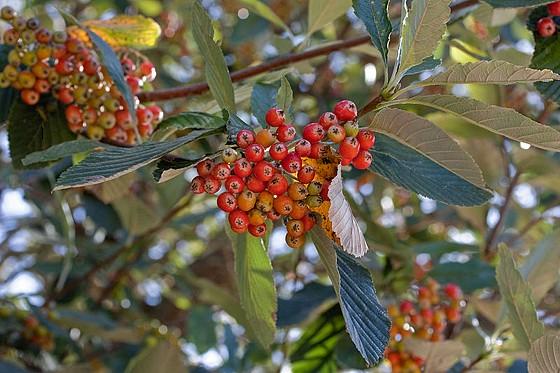
Sorbus aria (syn. Aria nivea), the Whitebeam or Common Whitebeam is a deciduous tree, compact and domed, with few upswept branches; it generally favours dry limestone and chalk soils. The hermaphrodite cream-white flowers appear in May, are insect pollinated, and go on to produce scarlet berries, which are often eaten by birds.
Sorbus
torminalis
Sorbo ciavardello
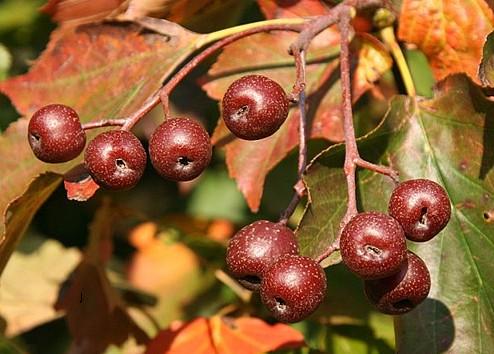
Il Sorbus torminalis o sorbo ciavardello o sorbo ciaverdello è una specie di sorbo appartenente alla famiglia delle Rosacee. La chioma è globosa, appiattita e densa. Può essere alto fino a 15 metri. Viene usato in erboristeria per le coliche dello stomaco e intestinali e per la dissenteria dato che il nome scientifico pare derivare dal sostantivo latino neutro plurale tormina (genitivo torminum) che significa coliche, dolori intestinali, e torminalis è appunto un qualcosa che è adatto a chi soffre di coliche. Vive in gran parte dell'Europa: Danimarca, Italia, Inghilterra, Galles, Polonia; in Asia minore, Caucaso e Africa del nord-ovest.
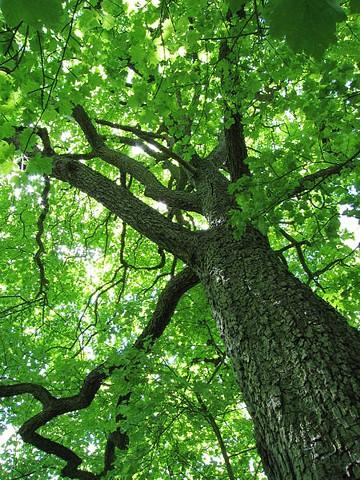
Wild
Service Tree
Sorbus torminalis
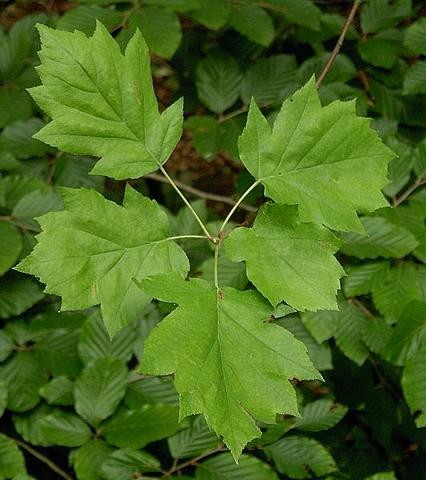
Sorbus torminalis (syn. Torminalis clusii, Wild Service Tree), sometimes known as the Chequer(s) Tree or Checker(s) Tree, is a species of Sorbus native to Europe from England and Wales east to Denmark and Poland, south to northwest Africa, and southeast to southwest Asia from Asia Minor to the Caucasus and Alborz mountains. It is a medium-sized deciduous tree growing to 15–25 m tall, with a trunk up to 1.3 m diameter. The bark is smooth and greyish, but flaky, peeling away in squarish plates to reveal darker brown layers. The leaves are 6–14 cm long and broad with a 2.5–5 cm petiole, dark green on both sides, with five to nine acute lobes; the basal pair of lobes are spreading, the rest more forward pointing and decreasing in size to the leaf apex, and with finely toothed margins. The undersides have small hairs when young, but both sides are smooth and shiny when older; the autumn colour is yellow to red-brown. The flowers are 10–15 mm diameter, with five white petals and 20 creamy-white stamens; they are produced in corymbs 5–12 cm diameter in late spring to early summer, and are hermaphrodite and insect pollinated. The fruit is a globose to ovoid pome 10–15 mm diameter, greenish to russet or brown, patterned with small pale lenticel spots when mature in mid to late autumn. There are two varieties:
Sorbus torminalis var. torminalis. Europe, northwest Africa.
Sorbus torminalis var. caucasica. Caucasus and Alborz Mountains. Leaves less deeply lobed than in var. torminalis.
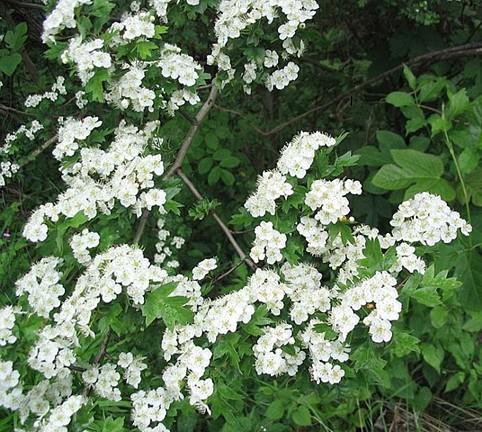
It is relatively rare and in Britain is now usually confined to pockets of ancient woodland, although it can also be found growing in hedgerows. It can often be found associated with oak and ash woods, preferring clay and lime based soils. In Britain, summer temperatures are often too low for the seeds to ripen, so its principal method of propagation is by suckers. A number of often very localised stable apomictic species of ultimately hybrid origin between Sorbus torminalis and various species in the subgenus Aria (whitebeams) occur in Europe, including Sorbus latifolia (Service Tree of Fontainebleau), and Sorbus bristoliensis (Bristol Whitebeam).
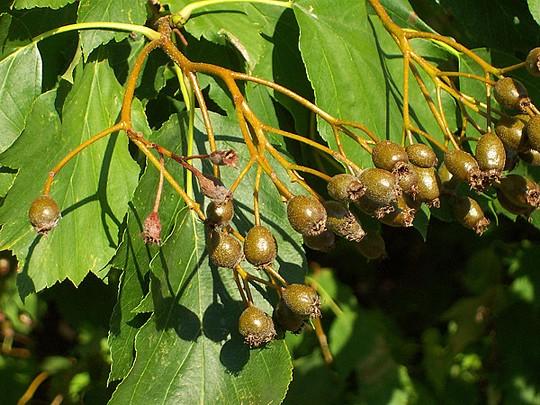
The fruit, sometimes called "chequers", are edible and taste similar to dates, although they are now rarely collected for food. They are usually too astringent to eat until they are over-ripe and bletted. They were traditionally known as a herbal remedy for colic; the tree's Latin name, torminalis means 'good for colic'. Before the introduction of hops, the fruit were used to flavour beer, which may be related to the ancient symbol of a pub being the chequer-board (although it has also been suggested that the pub name itself was originally brought by the Romans). Alternatively, the name "chequers" may have been derived from the spotted pattern of the fruit, though some suggest from the pattern of the bark on old trees.